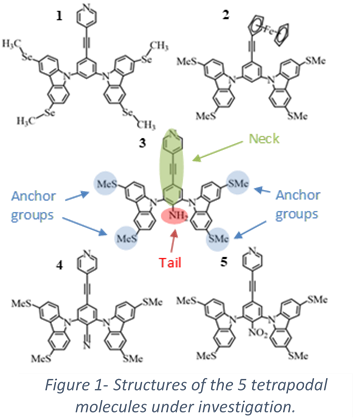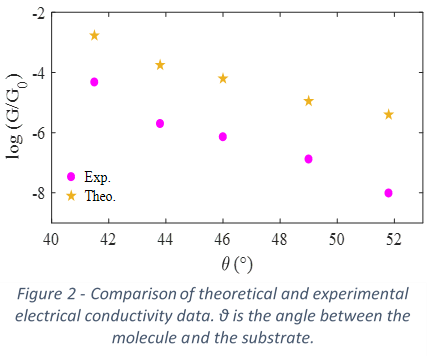Tetrapodal molecules studied by scanning probe microscopy methodologies for improved electrical conductance for thermoelectric applications
- Abstract number
- 344
- Presentation Form
- Poster
- DOI
- 10.22443/rms.mmc2023.344
- Corresponding Email
- [email protected]
- Session
- Poster Session Two
- Authors
- Miss Becky Penhale-Jones (2), Mr Ali Ismael (2), Mr Luke O'Driscoll (1), Mr Martin Bryce (1), Mr Colin Lambert (2), Mr Benjamin Robinson (2)
- Affiliations
-
1. Durham University
2. Lancaster University
- Keywords
Electrical Conductivity; Thermoelectricity; thin films; scanning probe microscopy
- Abstract text
Large, flat molecules, have been extensively researched for molecular electronics, however, they typically degrade quickly and are difficult to arrange as desired.[1] Multipodal molecules have been proposed as the next step in monolayer design, in order to improve anchorage to the substrate without inhibiting the conductance of the molecular backbone. Tripodal molecules have been demonstrated to improve mechanical interaction with gold substrates.[2] Research into multipodal molecules is of interest due to the potential for these materials in thermoelectric applications including thermoelectric generators and wearable technology.[3]
Here we report the results of a recently studied series of molecules with 4 anchors and an oligo(phenylene-ethyny-lene) based wire (Figure 1). Using advanced scanning probe-based approaches we have investigated how changing the head or tail group of the molecule influences its electrical conductance and thermoelectric properties. In the molecules studied, conjugation between the anchors and backbone was broken so as to minimise effects arising from quantum interference. Previous research has found that altering the anchor group made little difference to the overall conductance of the molecule,[3] hence for this work, functional groups were altered instead. This aimed to explore whether electron tunnelling is achieved between molecule and substrate when certain functional groups are employed at the base of the molecule. Furthermore, they were expected to alter the tilt angle (θ) of the overall molecule, and therefore packing density. The functional group at the top of the molecule was also altered and the influence of this coupling to the probe was observed.
Quartz Crystal Microbalance (QCM) and conductive Atomic Force Microscopy (c-AFM) were used to characterise thin films of the tetrapodal molecules. The experimental data for electrical conductivity obtained from contact AFM align well with the theoretical values (Figure 2).
- References
[1] Valášek, M. and M. Mayor, Spatial and Lateral Control of Functionality by Rigid Molecular Platforms. Chemistry – A European Journal, 2017. 23(55): p. 13538-13548.
[2] Davidson, R.J., et al., Conductance of ‘bare-bones’ tripodal molecular wires. RSC advances, 2018. 8(42): p. 23585-23590.
[3] O'Driscoll, L.J., et al., Carbazole-Based Tetrapodal Anchor Groups for Gold Surfaces: Synthesis and Conductance Properties. Angewandte Chemie International Edition, 2020. 59(2): p. 882-889.


